Chapter from the FAO Plant Production and Protection Paper 156
by the Food And Agriculture Organization of the United Nations
Date Products and Preparations
Dates
are ambiguous in the sense that, depending on the stage of maturity,
they can either be classified as a fruit, comparable to any other fruit
consumed between meals, or alternatively, as a food source as part of
the daily meal, in particular in the rural areas of the date producing
countries. Though not a true staple food by definition like rice,
potatoes or cassava, dates, on occasion, have been forced to play this
role for lack of other staples. In recent times, either because of a
decreasing demand for table dates or in an effort to make better use of
off-grade fruit, there has been a renewed interest in the date as a
food source, not necessarily as a staple food, but rather as a
component in food preparations like sweets, confectionery, baking
products, institutional feeding and health foods.
In this
Chapter a review is made of the use or potential use of dates in
combination with other foodstuffs. Only the use of the whole date flesh
is considered and therefore all quality standards as imposed on whole
dates, except perhaps for blemishes and other external defects, are
applicable.
Although demarcations are not always sharp, date
products and preparations, based on the use of the whole date flesh,
can be classified under: sweets, preserves, condiments, breakfast foods
and desserts . In order to follow somewhat the historical developments
in this field they are reviewed as home preparations, semi-finished
products, and ready-for-use date products after which research work on
new date products will be listed.
2.1 Home-made date preparations
Include
those dishes and foods for which whole dates are acquired by the
housewife and incorporated or combined for home consumption.
Preparation of the dates, according to the intended use, will normally
consist of washing, hand pitting, and either cutting, slicing or mixing
with water to prepare a date slurry.
Literature, both old and
more recent, is abound with references to dates being consumed in food
combinations and - preparations. The date's organoleptical and
nutrititional characteristics being what they are, that is rich in
sugar, and low in protein and fat, it stands to reason that a large
number of combinations are focussed on supplementing the nutritional
shortcomings and perhaps also diluting the natural sweetness of dates
and sometimes adding some acidity, which they lack. Fresh dates are
therefore often found in combination with milk (fresh and sour) and
milk products, such as yoghurt, curd, butter and cheese. Dates are also
stewed in fresh milk or thoroughly mixed with milk powder (513). A
refined delicacy consists of dates, butter and honey, named Khabis, and
reportedly known from the time of Mohammed, the Prophet (445).
Extending the date and protein combination, one comes across dates and
fish which has been a long-standing staple in the Gulf area (445),
which, incidentally, finds a reciprocal appreciation for dates by fish,
because in ancient Egypt dates were used as fish bait (127). Although
perhaps a strange combination to a Western palate it should not be
rejected off-hand if one thinks of the recipes in the West based on a
sweet with animal protein like apple sauce or prunes and pork,
cranberry sauce with turkey, which in Naples finds a parallel in turkey
prepared with a stuffing incorporating dates. But this tolerance for
accepting unusual food combinations would probably stop for most people
when being confronted with dates mixed with oil and boiled, dried and
ground locusts which apparently was considered a delicacy in those
countries where these insects are abundant from time to time (445).
Ground dates mixed with sesame oil is a well known dish and probably
most effective with which to pass the cold desert nights.
A
typical example of complementarity in the consumption of fruits and
vegetables is the combination of dates and either cucumbers or water
melons, in which the sweetness of the date is diluted and the taste of
the cucumber or water melon is reinforced. In more recent times these
combinations are extended to recipes for date fruit salads, using
pineapple, citrus, apples, pears, celery and lettuces.
Date and
starch preparations are frequently found and normally need cooking or
frying. Examples are dates stewed in fresh milk with onions and flour
or a stew of dates and rice in milk commonly used for lactating mothers
(445). Adding sesame paste (tehina) to cooked flour and dates adds
extra flavour to a product called Tamreyya (513) especially used in
winter and by women after childbirth.
Honeiny consists of
comminuted dates thoroughly mixed with a precooked thick dough and
reheated on a flat plate and served with butter (512). A common,
traditional dish based on dates and flour, found in many date producing
countries but with many variations is Asseeda. A traditional Asseeda
from East Saudi Arabia (512) would be made by roasting wheat flour
briefly (1,000 g.) and adding it to a coarsely sieved date/water
mixture (2,350 g., 11.5° Bx). After mixing thoroughly and adding
some pepper (3 g.) the mixture is spread on a flat metal plate with a
small amount of butter and cooked in the oven for 1.5 hours. Asseeda is
served with some more butter (40 g.) (512). However, there are many
variations of this recipe: other flours may be used (sorghum, millet),
date syrup or molasses may replace dates, and other spices, e.g.
cardamom can be added.
Dates are frequently used in home made
pastry. A typical date sweet (halwa tamr) is made by frying finely
ground dates with flour and milk and forming this mixture into cakes
(445). Another date sweet consumed on festive occasions in and around
Mecca is Debiaza, made by concentrating date juice, to which dates,
dried lemon and mint are added, until it gels (512).
Dates and
nuts (walnut, pistachio, almonds), and also sesame seed, are a
well-appreciated combination and frequently prepared in different forms
for home use. Nuts also often play a role in preparing home preserves
as shown from the following example: peel hard dates with a knife,
cover with water and boil until soft, remove seed and insert almond or
pistachio nuts and a clove, boil dates in syrup with lemon until thick
consistency, preserve in glass or glazed jars (445).
Another
more or less similar recipe adds, besides walnuts, sesame seeds and
powdered ginger before pressing and storing the mixture under syrup in
glass jars. Home made jams based on dates are also known, as the
following example from Egypt shows: cook semi-dry dates in water to
soften, remove skin and seed, and insert a clove, add half a cup of
sugar to one cup of dates, add lemon juice and original cooking water,
concentrate over low fire. Leaving out the lemon juice and clove and
replacing them with chopped walnuts gives another type of date jam
(122).
It is clear that this list of home made date preparations
in the traditional date producing countries is far from complete
because so many variations are possible depending on local availability
of other foodstuffs and prevailing traditions and customs.
The
situation in the countries without local (traditional) production of
dates is understandably different. In Europe the date is mostly used as
a table fruit and then only mainly before and during the Christmas
season, when lower temperatures and perhaps connotations of the date
with the Holy Land, work in favour of an increased consumption of whole
date fruit. Home made date preparations are more difficult to find;
however the more inventive housewife may mix some chopped up dates in
mixed salad, or fill up the dates with cheese as a cocktail snack
(183), or stuff them with nuts for an after-dinner sweet.
Dates
used in cooked foods are even more rare as witnessed by the paucity of
recipes to this effect in the European cook books. However, a few
interesting examples are given: (i) dates used in stuffing for chicken
and turkey. A first version combines dates in pieces with pine seeds,
minced meat, breadcrumbs, eggs, milk and spices; a second type uses
dates, potatoes, eggs, cheese, raisins and nutmeg (181). The chicken or
turkey meat can be further garnished with a sauce, prepared from dates
in butter, orange juice and some brandy. (ii) dates with rice. Date
pieces are lightly fried in butter, combined with slices of chicken
breast. This mixture is combined with rice cooked in broth with cloves.
(iii) date and fish. Sole or bass with some butter and herbs (thyme,
rosemary) together with dates rolled in a slice of bacon, are wrapped
together in aluminium foil and cooked in the oven (296). (iv) dates and
pasta: ravioli pasta is stuffed with date pieces (mixed with nuts, if
desired), deep fried and rolled in sugar (181). (v) date mousse. Dates
and nut pieces are mixed with yoghurt to which egg yolk and cinnamon
are added. The white of the egg is whipped separately with sugar until
foamy and incor-porated with the yoghurt mixture to form a light, tasty
dessert (182).
In the U.S., which only during this century
became a date producer in its own right, strong and persistent
promotional campaigns have made the housewife much more date-minded
than in Europe, reflecting itself in a variety of date uses including
cooked foods.
The emphasis on the use of date products prepared
in the home is on baked products like bread, cakes, cookies and
puddings either incorporated in the dough or as a filling. Dates are
often used in combination with other dried fruit, especially apricots,
raisins and figs. Also very popular are the admixtures with nuts,
coconut, chocolate and sometimes ginger and vanilla.
For more contrasting tastes the following suggestions are made by a U.S. date grower/packer (291):
a) for sandwich spreads
i. chopped dates and cream cheese,
ii. chopped dates, peanut butter, salad dressing in equal amounts, mixed lightly with some lemon juice,
iii. chopped dates with orange marmalade
b) for party snacks
i. dates, stuffed with cocktail sausage, oven baked and served on cocktail sticks,
ii. dates, stuffed with olives, rolled in thin cream cheese and chopped nuts,
iii. dates, stuffed with fondant, nutmeat or candied fruit,
iv.
date chews, consisting of a mixture of ground dates, chopped nuts,
shredded coconut, cream, vanilla, made into balls coated with sugar
c) for salads
i. chopped dates with grapes, peanuts, cottage cheese, bananas, or celery and nutmeats,
ii. dates stuffed with Philadelphia cheese on pineapple slice served on lettuce
A
recipe for a home-made date relish (134) combines chopped, pitted dates
with sugar and ground raisins, spiced with garlic, ginger, red pepper,
vinegar and a little salt. The mixture is boiled for 15 minutes and
used as a sweet-sour condiment.
In order to promote the use of
dates in home cooking the housewife is greatly helped by a number of
semi-finished and prepared date mixtures available on the market and
which will be reviewed in the next paragraph.
2.2 Semi-finished Date Products and Mixtures
The
base material for the further industrial use of dates in mixtures and
preparations are pitted dates, most of which are produced in macerators
as described in Chapter I: "pitting", although for special purposes
whole pitted, cut or sliced dates are also procured.
Out of this base material the following product range is available as semi-finished products:
a. macerated chips
in 50 lb cases , usually going to bakers and confectioners who further
convert it into the form desired by them. The product generally needs
refrigeration because of the borderline moisture content for
fermentation at which the date macerators operate most efficiently.
b. date paste:
a simple additional grinding operation will turn the macerated date
into date paste. The principle is the same as for prepared minced meat
and the fineness of the product can be regulated by the use of
different size holes in the discs. Here also, refrigeration may be
required to prevent possible fermentation. Date paste is also produced
commercially in Saudi Arabia and used for bakery products. The
estimated volume of this product is 1,000 tons in this country. A
curious non-food application of date paste is that it will, in
combination with soap, efficiently stop leaks in gasoline tanks in
automobiles (363). This will not open up large markets for date paste,
but it may become a life saver on long desert journeys.
c. extruded date pieces:
macerated dates are forced through dies with ¼" circular holes
and the resulting "sausage" is cut at lengths varying from ½" to
1" whilst being coated with dextrose (solid glucose) or oat flour to
prevent the pieces from sticking together. This product is sometimes
air dried for more firmness or customer preference.
d. diced dates:
a variant of above are diced dates which are cut up rather than
extruded macerated dates. The operation is performed in a dicer, which
can be set to produce pieces of about 3/16" to ½". They are also
coated with dextrose or oat flour to keep the pieces separate.
e. dehydrated dates:
macerated dates are put on trays and dried down to less than 5%
moisture in tunnel or cabinet dryers. The dried dates are ground and
sold in various screen sizes. The product is used in prepared cake-,
cookie- and muffin mixes.
Some of the products are also sold
directly to the public such as "extruded date pieces", "diced dates"
and a "date block", which is a slightly pressed cube of macerated dates
(10 oz or 1 lb size) for home baking.
A product under the name
of Date Crystals, dehydrated fine date pieces, almost a powder, was put
on the market and proposed as the basic ingredient in date recipes and
taking the place of dates (526, 609) (Fig. 64). Another semi-finished
product in the form of a spread, consisting of ground dates and sugar,
was marketed as a base ingredient for the preparations of mainly cakes
and desserts aimed as a raw material in the catering industry (434).
 | 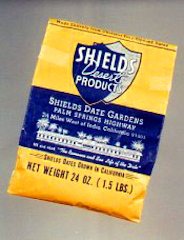 | | Fig. 64. Dehydrated dates in powder form |
A
second generation of semi-finished date products mainly developed in
the U.S. are the prepared foods which with simple additions and home
preparation can be turned into a ready dish. In this group belong the
breakfast foods in which date crumbs are normally used together with
other dried fruits, cereals and nuts (Fig. 65) and the ready mixtures
for date bread (Fig. 66), date cakes and date puddings in their various
executions. A specific example is the date bar mix (Fig. 67) which
needs only the addition of water, eggs, baking powder and other
optionals (e.g. walnuts, grated lemon rind, instant coffee, coconut)
and oven cooking for 30 minutes to produce date bars (171).
 | 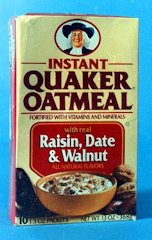 | 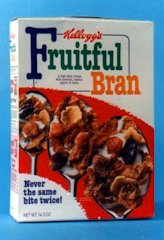 | | Fig. 65. Breakfast foods incorporating dates |
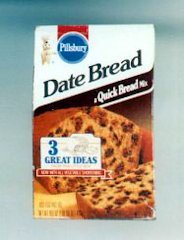 |  | | Fig. 66. Ready-made mix for date bread | Dig. 67. Date bar mix |
2.3 Ready for Use Date Products
Ready
for use date products incorporating dates are mostly found as sweets
and snacks though there are also some other examples where dates are
product ingredients.
In countries where taste for sweets, the
so-called "sweet tooth", is still prevalent, notably in the date
producing countries of the Old World, a great variety of coated and
stuffed dates as well as pastry based on or garnished with dates, is
available.
Dates filled with nuts and coated with chocolate or
stuffed with brightly coloured fondant are only a few of the many date
based sweets. Date pastry like halwa or date cookies (a sister of the
Wellington or fig bar) and date wafers can be found in many countries
(Fig. 68). In the U.S., and to a lesser extent in Europe, the
popularity of dates especially in the Christmas season, has given rise
to a gift parcel trade. It includes attractively packaged and arranged
dates and date products which are, on order by the customer, sent by
the producer as gift parcels through the postal system. The date
products may consist of stuffed and coated dates, date cake with
walnuts, date/plum pudding, date preserve and dates in brandy.
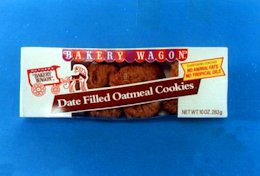 | 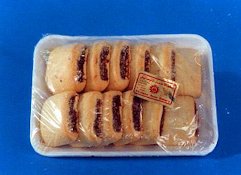 |
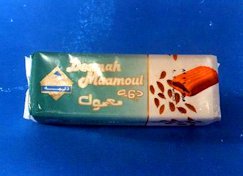 |  |
 |  | | Fig. 68. Several types of date cookies |
A
popular sweet as a snack is the date nut roll. It is a cylindrical bar
of about 3/4" and up to 2" in length of macerated dates, rolled in
coconut and with an almond on top. A date-muesli bar (Fig. 69)
consisting of hazelnuts, date syrup, dates, oatflakes, and sunflower
seeds, is another example of a one-portion snack. Another product, also
under the name of date nut roll is a canned ready date cake (based on
dates, nut meats, coconut, flour and other minor ingredients), to be
heated "au bain marie" and served after slicing with either sweet or
spicy toppings (382). Less sweet and in analogy with the early desert
travellers carrying dates along as a concentrated, high energy food,
are the so-called trail snacks, mixtures of dried fruits including date
pieces and nuts taken along on mountain hikes especially by younger
people (Fig. 70).
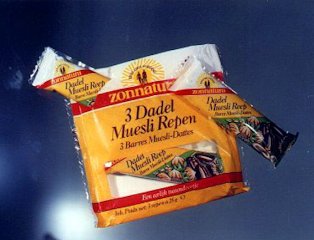 | | Fig. 69 Date-muesli bar |
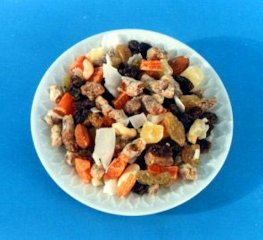 | 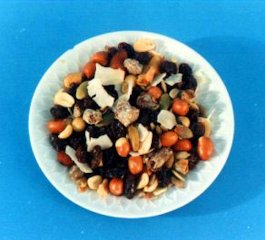 | | a) | b) |
 | | c) |
Fig. 70. Dried fruit and nuts mixtures including dates: a) Raw trail mix b) Roasted trail mix c) Tropical mix Date
jams in different forms or admixed with other fruits are part of the
product assortment of a few internationally oriented conserve
industries (Fig. 71).
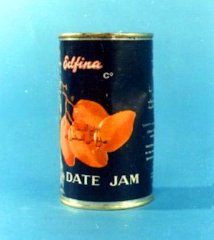 | | Dig. 71. Date jam |
In
conclusion of the ready date products available on the market mention
should be made of several condiments, mixtures of sweet, sour and
spices: date chutney (Fig. 72), steak sauce and pickles. In date
chutney all or part of the mango (for which chutney as a product is
better known) is replaced by dates, and mainly used as a condiment in
rice dishes. Steak sauce (better known as HP sauce after the company
that makes it) is a very old product, and is used as a condiment in
meat dishes. It contains about 10% finely ground, sieved dates. A more
fruity version is used as a general condiment (Fig. 73).
 | | Fig. 72. Date-banana chutney |
 | | Fig. 73. Steak sauce |
A
product in between chutney and steak sauce is a pickle incorporating
dates known under the name of Branston (named after the town where it
was first created). Besides dates the different versions contain
vegetables (pieces), fruits and spices. Its pleasant sweet-sour taste
makes it an appropriate accompaniment to salads, cheese and cold meats
(Fig. 74). A sweet type of pickle is shown in Figure 75.
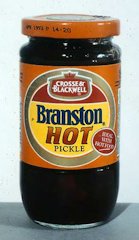 |  | 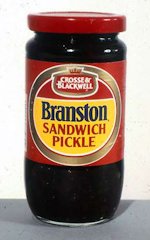 | | Fig. 74. Different types of pickle incorporating dates |
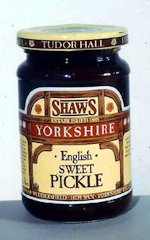 | | Fig. 75. English sweet pickle |
2.4 Date Products Development
The
development of new products derived from dates to create more product
diversity and marketing outlets has always existed and principally
originated from small scale private initiatives of a localized nature.
However, in the fifties and early sixties a strongly increased interest
in date products development can however be observed, especially in the
U.S., the reason being to broaden the marketing base of the date crop
and upgrading the quality standards of choice table dates by being able
to use the sub-standard fruit for date products. The initiatives were
undoubtedly also inspired and helped by a strongly emerging prepared
food industry in the U.S. in which the date producers desired to have a
part. Many of the Annual Reports of the Date Growers' Institute in this
period bear witness to this research both by private and public
initiatives, and many of the products referred to in the previous
paragraph had their roots in this development work (123, 124, 125, 302,
527, 31). With the gradual change of ownership of the date plantations
and concentration of date products use in large multi-food companies,
development work nowadays is largely done under cover of proprietary
rights and does not come out in the open as it used to. This phenomenon
is also confirmed by an increasing number of patent applications in
this field.
In the Old World, Iraq has been the leading country
in date products development, especially in the industrial use of the
date. Its National Date Research Centre has operated for many years and
hosted the Headquarters of the FAO/UNDP Regional Centre on Palm and
Date during the period 1975 to 1985. North Africa has contributed to
these developments though the main emphasis has been on improving
(export) quality of table dates of the Maghreb countries and some
industrial uses of low quality dates in Libya and Egypt. As will be
remembered, most of Egypt's date crop is consumed fresh.
Over
the last ten years Saudi Arabia has entered the field of research on
dates, a parallel development to the strong promotional efforts by the
Government to improve and increase date production and processing. The
research activities are now centred at the National Date Palm Research
Centre located at Hofuf, Al Hassa.
By 1971, 5,000 new products
of all kinds were presented yearly to the U.S. supermarkets, an amount
about equal to the available items of most supermarkets at that time
(610). These numbers will probably have increased since then and it is
obvious that only a few newly introduced products can survive in the
long run. Proportionally, date products will be no exception as is
shown from the experiences of date products that have vanished or have
been replaced by newer developments. The European and local markets in
the date producing countries will show similar signs and the conclusion
is that the commercial introduction of a new date product is a tedious
process which needs a thorough knowledge of customers' habits and
tastes with regard to food, assured raw material supply and
distribution systems, secured keeping quality of the product, potential
market volume, and competitiveness with closely related products. In
addition, trends in consumer preferences should be recognized and
exploited by responding to them. It further needs capital and much
promotional effort.
In the last twenty years there have been
numerous attempts to improve existing formulae and develop new date
products as reflected in the technical literature. However, little is
known about the rate of success, i.e. whether the idea remained
conceptional, or reached pilot scale production and marketing, or
became a commercial success.
The following overview of research
on date products development over the last twenty years or so is
therefore given in the light of technical interest and perhaps as a
source of ideas for date products promotion. For convenience and
clarity the products have been classified in groups, reminding the
reader that only the use of the date flesh, of comparable or nearly
comparable quality as that applicable to whole dates, is considered in
this chapter.
a. Whole pitted dates:
Various
products can be mentioned that in some way provide a new use for dates
in a date product. The first consists of a fig stuffed with roasted
almond, a date, raisins and a bonbon, and then coated with chocolate
(130). Another replaces the date pit with an almond, cooks the filled
date in sugar syrup, thereby imparting a golden colour to the date and
syrup (324). The preservation of dates in syrup is long known and
practised but has also been the subject of additional development work.
In these tests peeled and pitted dates were placed in 50° Bx syrup
of which PH was adjusted by citric acid from about 7 to 3. The mixture
was boiled down to Bx 75°, and various flavours (orange, banana,
grapefruits etc.) added (275, 276). Whole, pitted rutab spiced with
clove and cinnamon, stuffed with almond (if desired) are put into jars
and a slightly acidified sucrose solution (70oC Bx) is added under
vacuum to ensure good penetration of the liquid in the date cavity.
After sealing, the jars are pasteurized for 20 minutes at 90°C in a
waterbath (65). Another development involves an apparatus which
combines pitting and filling the cavity of dates with a suitable
mixture or almond in one operation. The resulting filled date, if
desired, is then sent for coating with chocolate (312, 580). In analogy
with the long established process for candied fruits, this technology
has also been tried on khalaal (276, 506). Washed and pierced (to
facilitate exchange of materials) khalaal were immersed overnight in a
35.5° Bx syrup (composed of equal amounts of sucrose and glucose
syrup), of which the PH was adjusted to 2.8 by a mixture of citric and
ascorbic acid. After briefly bringing to the boil, Bx content was
increased by 5-10° at 2-3 day intervals until a Bx level of 75°
was reached. Originating from a date of about 40% dry matter (of which
about 84% was sugar), a product resulted of over 80% DM (of which about
86% was sugar).
Canning of khalaal has been the subject of a
study (322) but no definite recommendations as to the procedure, which
consisted of washing, pitting, blanching, can filling (with sugar
syrup, citric and ascorbic acid), exhausting, sealing, sterilization
and cooking, could be arrived at.
b. Pure date paste:
The
technical aspects of making date paste are simple and is normally done
in mincers. The fineness of the grind can be adjusted by changing dies
with holes of different diameter. The texture (softness) of the product
is mainly determined by moisture content, but not by this alone.
Different date varieties of the same moisture content may produce a
paste of different softness. Moreover, date paste will tend to get
harder during storage, even when maintaining the same moisture content.
Add to this the increasing risk of browning and fermentation with
increasing moisture, it is clear that the characteristics of the raw
material and the desired end product must be matched by technological
manipulation. Evaluation, standardization, and storage stability of
date paste were subject of a study (on one date variety: Ruzeiz)
reported in two parts (607). The main results of these investigations
are:
- moisture content can be satisfactorily adjusted (upward)
by either steaming or soaking of the dates prior to grinding. (Normally
one will start with dry dates for producing a paste of around 20%
moisture. If dates of a high moisture content have to be turned into
paste of 20%, dehydration would have to be applied.) Within the
normally required range (say max 10% increase in moisture) during steam
treatment (5 min.) and soaking (10 min. at 25° C) no significant
leaching loss will occur,
- soaking of Ruzeiz dates (12.38%
moisture) for 10 minutes raised the moisture content to 22.09% with
water activity of 0.57, well within the safety limit for fermentation,
-
Ruzeiz date paste of about 18% moisture (pre-steamed) and 22%
(pre-soaked) stored at respectively 5°, 25°, and 50° C
did not show appreciable difference in colour, PH and total sugar
content for 16 weeks at 5° C, 8 weeks at 25° C and 3 weeks at
50° C,
- addition of 0.2% citric acid, which lowers initial
PH from 5.96 to 5.40, perhaps desirable from an organoleptic point of
view, does not significantly change storage stability except perhaps
for PH at 25° C at which the paste remains more stable than the
control,
- the same applies to addition of 0.2% citric acid + 0.2% ascorbic acid.
In
the context of date paste making mention should also be made of several
attempts to produce date paste sheets, named tamaruddin in analogy with
the well-known and widely distributed apricot "leather" (quamaruddin).
There are, however, two basic differences between the two raw
materials, which makes the date the less favourite for such a product.
Whilst the apricot can be turned into sheets from its natural state by
pulping, screening and drying on boards, dates have to be diluted first
to be pulped, after which the water has to be evaporated again.
Secondly, the date's natural less pronounced flavour and acidity make
it less suitable as a base for a reconstituted drink for which this
paste is mainly used. The experiments carried out (379, 388, 389)
reflect these shortcomings which have been tried to overcome by
addition of organic acids, and/or other fruit pulps and flavours. In
this way fruit pulp mixtures are created which under certain conditions
may find a place in the market or as a semi-finished product.
c. Date paste mixtures
With
the possibility of producing a date paste with the desired moisture
content, texture and softness well in hand, the field to combine and
supplement this basically sweet material with other foodstuffs is wide
open and many proposals have been made:
- premixed date bar
(including almonds and corn starch) supplemented with respectively soy
protein isolate (SPI), single cell protein (SCP) and dry skimmed milk
(DSM), resulted in a nutritional balanced mixture and scored well with
moderate variations in sensory testing compared to control, also after
prolonged storage (up to 6 months) at 7° C and 25° C. Similar
product mixes based on protein supplementation by SPI, SCP and DSM have
been reported (270, 259, 496, 144), as well as date paste/roasted
peanut mixtures (487, 578). All these studies were aimed at creating
acceptable, nutritious snacks for children.
- nutritious candy
bars based on date paste mixed with corn starch, whole dry milk,
roasted almonds, coconut, sesame butter and milk chocolate (as
coating), in various proportions. Date paste constituted from 74-84% of
the final weight according to recipe (6 in total). Moisture content
ranged from 14.9-16.6%, protein 4.78-5.98% and fat 7.28-15.17%. Sensory
testing showed a preference for chocolate coated bars. Storage tests
showed a decline in quality after two months at 40° C and five
months at 28° C, whilst the samples stored at 5° C remained
unchanged (604).
- tamrina, a protein-rich food mixture for
feeding infants and pre-school children (600) is based on a variety of
mixtures of wheat, lentils, chickpeas, dates, milk powder and vitamin
supplements. The process is as follows: wheat, lentils and chickpeas
are cooked for 15-20 minutes with just enough water for total
absorption. The cooked mixture is then dried at 70° C on trays in a
drier. Pre-dried pitted dates (50° C) are mixed in and the total
mass ground to 70 mesh. The other ingredients (milk powder and vitamin
supplement) are added and the whole mixture is packed in aluminium
lined polythene and stored at 4° C and room temperature up to 6
months. Dates constitute 10% of the mixtures before preparation. The
final products, varying according to the recipe, range 5-6% in
moisture, 19-20% in protein, 2-5% in crude fat, 10.5-14.5% in sugar and
45-47% in starch. Organoleptic evaluation was favourable, even after
six months storage. The product was created with the intention of using
as many locally available materials as possible and substituting sugar
for dates.
- tamarheep (a contraction of tamr (date) and haleep
(milk) is an effort to create nutritionally balanced date mixtures
following the process of apricot leather, i.e. pulping, screening,
mixing and drying into sheets. In the experiments under review
(380), apricot leather was compared with pure date leather and a number
of date leathers reinforced with skim milk powder (DSM) (respectively
20, 35 and 50 gm to each 300 g date pulp, which corresponds to 120 gm
of dates). In addition the basic tamarheep (i.e. dates + DSM) were
flavoured with different fruit flavours and the resulting multitude of
products were tested by a taste panel. General conclusions were a
preference for apricot leather but good appreciation for tamaruddin
(date leather) and plain tamarheep and some of the fruit flavoured
tamarheep, either in solid form or reconstituted.
A chocolate
and vanilla flavoured drink from a whey/milk mixture sweetened with
date puree and sugar was successfully tested and rated well compared to
the control based on sugar only (200).
d. Date paste in bakery products and confectionery
The
use of dates and date pieces in bakery products and confectionery has
been reviewed earlier in this Chapter and several commercial products,
mainly of American origin, were identified. The use of date paste for
this purpose is much less common and was investigated for possible
application in bread and cookies by large-scale modern bakeries (370,
605). In these experiments wheat flour (12.40% moisture, 13.07%
protein, 1.33% fat) was replaced by date paste (15.82% moisture, 78.24%
total sugars, 2.24% protein, 0.35% fat) at the respective rates of 0,
4, 8, 10 and 12% in bread. For cookies 0, 10, 15 and 20% replacement
was adopted with corresponding adjustment of sucrose addition to keep
total sugar constant in all samples. Overall outcome of testing the
resulting samples was:
- bread specific volume was highest at 8% addition of date paste
- at 12% the dough is sticky and typical bread characteristics are distorted
-
sensory testing by a taste panel revealed a preference for the control
(i.e. 0% date paste) on all test criteria (crumb texture, appearance
and flavour) for the bread samples
- in the case of cookie testing the results were opposite with highest rating for 20% addition of date paste
- cookies showed less tendency of cracking with increasing paste content
On
the basis of these results it would therefore seem that application of
date paste in cookies will have a better chance of success than in
bread making.
In another study (395) replacement of 50% sucrose
by date paste in cookies resulted in, besides the organoleptic
improvement, a higher moisture retention and prolonged shelf life of
the product.
e. Date preserves
Preserves
are normally understood to be derived products created to prevent
spoilage of fresh foodstuffs in order to extend their storage life and
availability to the consumer. Common natural auxiliary materials to
assist in this process are sugar, salt and (organic) acids.
Though
dates at the tamr stage would not necessarily fall into the fresh food
category because they are self-preserving, several date preserves have
been experimented with or reached commercial application, perhaps more
for the purpose of broadening the date product choice than for the
effect of preservation.
Fruit jams are one of the most common
preserves and the process consists of boiling fruit or fruit pieces
with sugar to a consistency where microbes are not able to grow. If
required, pectin is added to secure gelling and the PH is adjusted by
citric or tartaric acid. The resulting product is hot filled in jars or
cans, closed, and usually pasteurized in a hot water bath. Upon cooling
the product will gel. Densities may range from about 60 to 70° Bx
and a PH in the range of 3.2 - 3.5. Most food laws require a minimum
percentage of fruit pulp in the final product.
Dates are,
because of their natural composition, not the most adaptable type of
fruit for jam making because of their high sugar content, their
comparatively high PH and less pronounced flavour. Naturally occurring
pectin varies with the type of date and normally needs to be
supplemented especially when a lighter type of jam is desired. Several
research institutes have therefore analysed varieties and experimented
with date jam making to find the most suitable types and recipes (553,
276, 330, 331, 498, 367). A typical date jam recipe and analysis is as
follows:
Khudairy date jam, Saudi Arabia (355)
Recipe:
| Date pulp (62.4% date flesh) | 55 kg | | Sugar | 45 kg | | Citric acid (as % of dates in pulp) | 1.02 |
Mixture boiled down to Brix 66-68°
Analysis: PH 3.7, Brix 67.2°, Date/Sugar ratio + 0.75
In testing the suitability of dates at the different stages of maturity (khalaal, rutab and tamr)
it was found that rutab lends itself best for jam making before tamr,
whilst khalaal should not be considered for its low solid content and
lack of specific date flavour (357).
With the present overall
trend to produce lighter jams of less sweetness there may be scope to
finish the jam at a lower Brix (within the limit of the law) and to
consider dates combined with other fruit mixtures to create specific
flavours.
A product slightly different from date jam, named
date-butter, was made experimentally with the aim of, a.o., creating a
semi-finished product for further use by industry such as
confectioners. The difference with date jam consists mainly in a higher
date/sugar ratio, lower acidity (PH 4.6) and higher final Brix (around
75°) (276). Along similar lines as experimented earlier (125),
canning of date pulp was attempted for eventual use as a semi-finished
product for the food industry. Difference with the date jam and date
butter processing is that no cooking takes place. Best results were
obtained by blending date pulp (made of steamed dates) with a 20°
Bx sugar solution or date liquid sugar solution. This blend is
homogenized, adjusted for PH (3.9), packed and sealed in cans and
sterilized, because the product is perishable (around 50° Bx) (335).
Whilst
raising the sugar content of food to a high level is a form of
preservation to exclude microbial growth, pickling consists of both
controlling some and encouraging growth of other microbes (not harmful
to humans), in order to reach a situation in which the product is both
preserved from microbial deterioration and remains edible. To reach
this condition quite often use is made of salt which selectively
controls microbial growth. Examples are fermented cabbage
("sauerkraut") and a wide variety of pickled fruits and vegetables,
like gherkins, cucumbers, cauliflower, olives etc. However, high sugar
containing fruits like deciduous fruits, are not suitable for this type
of preservation and the fully mature date therefore would not seem a
promising candidate. Nevertheless, some work has been done and the
first interest has focussed on the pickling of dates at the kimri and khalaal
stages, i.e. when they are perishable, low in sugar, high in moisture
and mostly astringent. Up to a point the comparison with olives is
valid, except that olives have a high oil content.
A first
report on the subject (277, 276) deals with a method, called fresh-pack
pickle, which does not involve fermentation, because dates are packed
in an acidified sugar solution and immediately pasteurized. Other
particulars of this experiment were: 3 varieties of dates at the kimri
stage were washed, peeled in an abrasive drum peeler, hand pitted and
cut in slices. They were packed in a 20% sugar solution with a varying
(acetic) acid level (2.0, 2.5 and 3% of a 5% standard acid strength
solution respectively). 3% salt, 1.5% spices and 0.05% sodium benzoate
were added to all samples. Pasteurization time and temperature were
also varied but proved optimal at 71° C for 15 min.
Major results of these tests were:
-
after 3 months storage, total acidity in the solution drops and PH
values increase; total soluble solids decrease. These changes level off
sharply in the period up to 6 months storage. Conclusion: product has
stabilized after 3 months
- in sensory testing no clear
preferences for either variety or acidity range could be detected and
all samples came out as acceptable for colour, taste and texture in the
range of 7 (out of 10).
In a sideline of the above main
experiments one variety was stored in salt solution for 2 months before
being used as salt-stock in the main experiment. The preparation of the
salt-stock went as follows: dates were covered with 12% salt solution,
which after one week was raised to 15% and maintained until
stabilization. After two months at ambient temperature the dates were
removed, washed several times with running water to remove salt, and
further treated as for the fresh-pack pickle. The initial acidity of
the salt-stock as lactic acid was found to be 0.49% which is considered
low though it shows fermentation had taken place. In the analyses of
the subsequent pickles derived from this salt-stock according to the
fresh-pack recipes, the decrease in total acidity, increase in PH was
not so pronounced as for fresh-pack pickles after 3 and 6 months
storage, but the decrease of total soluble solids in solution followed
the same pattern.
Other experiments on kimri and khalaal
pickling resulted in satisfactory products using 15% salt solution and
2% acetic acid after 6 weeks for kimri (417) and 10% brine plus 2%
acetic acid, boiled for 5 minutes, for khalaal (603).
In another
effort of date pickling (201) dates were pickled following two methods:
"fresh brine pickling" and "salt-stock pickling".
In the fresh brine pickle dates (kimri
stage, 70% moisture, PH 6, Bx 16-18° ) were given two vertical cuts
and placed in jars covered with 32° Salometer salt solution (n.b.
100° Salometer corresponds to 25% salt solution) and 2% vinegar (of
4.5% strength) was added. In a parallel lot the fruits were cut but no
vinegar added, and in a third lot the fruit was not cut but brine and
vinegar were added. After 90 days of fermentation the brine solution
(32°) is renewed including 5% vinegar, packed in jars and sealed,
and pasteurized at 80° C for 15 min. in hot water.
In
salt-stock pickling the fermentation is started with 32° salt
solution, after which at weekly intervals 2% salt is added until after
4 weeks the solution has reached 60° Salometer. After 90 days the
fruits were freshened with warm water for 8 hours at 50° C
(repeated twice). Fruit is then treated as for fresh brine pickle at
the second stage. In both methods some lemon and dill were added for
extra flavour.
Main results of this study were:
- in
spite of rather slow fermentation rate (12 weeks) in fresh brine
pickling, acceptable PH (3.45 - 3.85) and total acidity levels (0.80 -
0.90%) were reached, the samples with vinegar having the higher acidity
levels
- in the salt-stock pickle it took up to 24 weeks to reach the extreme acidity levels of the fresh brine pickle
- cutting the dates or not had no appreciable influence on the process
- samples to which vinegar had been added were preferred in all cases during sensory testing
- the addition of lemon, dill and stuffing of piemento red pepper enhanced the acceptability of the product
- a negative comment on quality concerned the toughness of the pickle
It
is evident that with these experiments, valuable as they are, the
possibilities of pickling dates at the kimri and khalaal stages have so
far not been exhausted. The process variables and techniques, the
sugar/salt/acid ratios and the use of additional flavours are numerous
and provide many opportunities for extended research in this area.
Attractive, appetizing date pickles could become a welcome addition to
the date product variety and date outlet possibilities.
f. Date condiments
A
condiment is characterized by a specific flavour and is used to give
relish to food. In Heading 3 of this Chapter several commercially
available condiments containing dates were identified. Two additional
efforts to incorporate dates in condiments are referred to: they are
concerned with date chutney and tomato ketchup. Chutney is a generic
term of a condiment composed of a sweet (provided by fruits), acid
(provided by lemon or vinegar), vegetables and (hot) spices. Chutney
(derived from the Hindu chatni), is probably best known when mango is
used as the basic fruit, but also apple, tomato and mixed fruit
chutneys are known, so why not a chutney predominantly consisting of
dates? In trying this, 6 prototype samples of date chutney were
prepared (276, 505) in which the following ingredients were
incorporated:
- dates: either as chopped pieces or as pre-prepared pulp
- raisins
- sugar
- vegetables: carrots, onions, piemento
- spices: ginger, cayenne pepper, paprika, coriander, cinnamon
- vinegar/acetic acid
- other additives: salt, casein powder, gum arabic, water
The
preparation of these chutneys consisted of boiling the carrots, chopped
dates and raisins with water and date pulp for 15 minutes after which
the sugar and seasonings were added followed by a further boiling for
20 min. The major characteristics of the samples were: PH 3.57-3.65;
Brix 50.2-51.2°; Total sugars 35.4-37%; Acidity (as acetic acid):
1.22 - 1.39%.
In sensory evaluation (15 panel members) no
significant preferences for one or more of the 6 samples came out but
the overall appreciation of the product was favourable.
Tomato
ketchup (derived from the Chinese Koe-chiap) is now mostly known as a
sauce of homogenised tomato pulp mixed with sugar, vinegar, salt and
flavouring (sometimes hot spicy). In an attempt to make more and better
use of local resources experimental work was carried out (336, 337) to
substitute sugar for dates in tomato ketchup. Starting from a standard
recipe which contained tomato juice, salt, sugar, vinegar, pectin,
onion and a number of condiments (garlic, red chillies, paprika,
nutmeg, cloves, cinnamon, cardamon, ginger, coriander, and aniseed),
the preparation of the ketchup consisted of extracting tomato juice
from fresh tomatoes (heating in water, straining) mixing in the other
ingredients and boiling down to the required Bx content. Major
characteristics of this standard sample were: Dry matter 33.9% (Bx
32° ), PH 3.62, acidity (citric acid), 1.16%, sugar total 26.5%. In
the preparation of the test samples sugar was progressively replaced by
date pulp (prepared from steamed, pitted, homogenised dates mixed in
equal mounts with a 20% sugar solution, slightly acidified with citric
acid). The rates of sugar substitution were respectively 25, 50, 75 and
100%. The chemical composition of these samples, as a consequence of
this substitution, showed a slight increase in PH and reducing sugars,
and increasing mineral, crude fibre and fat contents. The results of
the test panel according to the report, showed no significant
difference in colour, flavour and consistency of the various samples,
but was not conclusive on overall taste.
g. Date desserts
Past
records (302, 123) make mention of development work on the use of dates
in desserts, like ice cream and puddings and some of these products
have reached commercial application, the extent of which is difficult
to judge but mostly concentrated in the U.S. More recent development
work has also been done in the Arab World as part of the overall effort
to provide more diversified marketing outlets for the date fruit.
The
following examples are quoted: dates in the form of date juice (diluted
and strained date paste), were used at different levels as sweetening
and flavouring agent in water ice, fruit sherbet at 20, 25 and 30°
Bx and ice cream. From a technological viewpoint the following results
were obtained: Overrun (i.e. the percentage increase in volume of the
mix caused by beating-in of air) as well as viscosity increased with
higher Brix. Increasing Bx content from date juice reduces meltdown
time, however. The sensory evaluation revealed no significant
difference in water ice for flavour, body/texture and colour, hence the
lower level of 20° Bx at the different Bx levels could be
considered sufficient. For fruit sherbet and ice cream a statistically
significant preference with regard to flavour for 20° Bx addition
was observed equalling the rating for the control ice cream (15%
sucrose). General result of these tests are therefore that date juice
at 20° Bx can replace sucrose partially or completely in water ice,
fruit sherbet and ice cream (532).
In a similar experiment
strained and unstrained date juice derived from date paste was used to
replace sucrose in ice cream at the rate of 17, 34 and 50% (w/w of
sugar value) respectively. These substitutions created an increase in
freezing time and decrease in overrun for unstrained date juice.
However for strained date juice (through cheesecloth, which removes
skin particles and coarse fibre) this was not the case. Melting time
was increased with increasing amounts of sucrose replacement and
melting quality remained stable in all samples. Sensory testing rated
ice cream with highest sucrose replacement (50%) as significantly best.
In a parallel test date chips were added to ice cream at the rate of 5,
10 and 15% to the control sample (0% sucrose substitution). Percentage
overrun was decreased (from 80 to 75% for 15% addition of chips),
freezing time was not affected, but melting time was increased. Sample
with 10% chips were rated first in sensory evaluation (203).
Dates
combined with yoghurt has not received much attention in date products
research, which is somewhat surprising whilst the yoghurt fruit
combinations on the market nowadays are numerous. The popularity of
these products has brought about the establishment of a specialized
industry which at the client's preference prepares fruit mixtures,
ready for incorporation in yoghurts, confectionery and ice creams.
However, so far dates have not played an important role in this
development. One study (464) focusses on incorporating dates (tamr) in
an existing product made of fermented and dried milk (oggt), creating a
new product tamroggt. Oggt is a traditional preservation technique for
milk, which is fermented, churned, the butter removed and the remaining
butter milk is boiled down to a paste. This paste is formed into
patties which are further dried in the sun. Moisture content in these
traditional products may range from about 4 to 8.5%, fat from 16-23%
and protein from 44-48%. In the experiment oggt was made from
reconstituted skimmed milk powder, thus by-passing the churning
process, and using a common yoghurt starter. Boiled down to a paste,
pitted, chopped dates were added in different proportions and the
samples dried at low temperature.
The sample in which equal
mounts of dates and skimmed milk powder were present had the following
composition: Moisture 10%, protein 25%, total sugar 60%. In two other
samples the date ratio was cut by half and replaced respectively by
0.1% anice and 0.2% sesame seed in one, and 1% cocoa in the other. In
sensory evaluation, the cocoa flavoured sample did not fare well; the
tamroggt with anice/sesame addition came out highest, followed by
tamroggt and the control oggt.
The use of dates in puddings has
already been referred to earlier but it seems appropriate to conclude
this chapter on "Date fruit products and preparations" with a recipe of
such a dessert, because the proof of the pudding is in the eating, as
the English saying goes. And that applies to all the date products and
preparations which have been reviewed in this Chapter.
Spiced date bread pudding (465)
2 cups warm milk, ½ cup sugar, ¼ tsp salt
1 tsp freshly grated nutmeg, ¼ tsp vanilla
½ cup pineapple or other fruit juice
Mix
and pour over 2 cups cubed day-old bread, soak for 10 min. and stir in
three quarters of a cup of chopped dates, 3 beaten eggs, and half a cup
nutmeats.
Bake pudding in greased baking dish, set in a pan of
hot water in moderate oven (350° F, 175° C) for about 1 hour.
Serve hot or cold with cream.
Bibliography
(513) SHAARAWY, EL-, M.I. (1989) Dates in the Saudi Diet. Proc. Second Int. Symposium on the Date Palm, Saudi Arabia.
(445) POPENOE, Paul. (1973) The Date Palm. Edited by Henry Field. Field Research Projects, Coconut Grove, Miami, Florida, U.S.A.
(127) DARBY, W.J. GHALIOUNGUI, P., GRIVETTI, L. (1977) Food: the gift of Osiris, Vol. 1. Academic Press, London.
(512)
SHAARAWY, EL-, M.I., MESSALEM, A.S., SABER, Nadia M., AL-JOHAR, M.A.
(1989) Common date containing dishes in Saudi Arabia. I: Asseeda, a
preliminary study. Proc. Second Int. Symp. on the Date Palm, Saudi
Arabia.
(183) GRUNIGER, Ursula. Alles over kaas (All about cheese) (Dutch). Published by Luitingh (Laren, Netherlands).
(181) GUARNERA, A. Private communication.
(296) LIONELLO, N. (Rome, Italy) Private communication.
(182) GUARNERA, C.m Private communication.
(291) LAFLIN DATE GARDENS The story of dates and treasury of date recipes. Company folder, Thermal, Cal., U.S.A.
(134) DOWSON, J. (1960) Private communication.
(363) MUNIER, P. (1973) Le Palmier Dattier. G-P Maisonneuve et Larose, Paris. ISBN 2-7068-0563-3.
(526, 609) SHIELDS, E.F. Recipes using Shields Date Crystals. Company pamphlet, Shields Date Gardens, Indio, Cal.
YOWELL, Hillman, HAVIGHORST, C.R. (April 1957) New product - New process Granule dates. Food Engineering.
(434) PATERSON, R. & SONS LTD. Neill's Date Spread. Company pamphlet, Glasgow, Scotland.
(171) GENERAL MILLS. Betty Crocker Date Bar Mix. Company pamphlet, General Mills Inc., Minneapolis, Minn., U.S.A.
(382) NATIONAL BISCUIT CO. Dromedary date nut roll. Company pamphlet, Nabisco, New York, N.Y.
(123,
124, 125, 302, 527, 31) CRUESS, W.V., MUSCO, D. (1952) Date Products
Investigations. Date Growers' Institute, Vol. 29.; CRUESS, W.V.
(1953) Date Products Experiments. Date Growers' Institute, Vo. 30.;
CRUESS, W.V. (1954) Canned sieved dates. Date Growers' Institute, Vol.
31.; MAIER, V.P., SCHILLER, FRANK K.H. (1958) Date Research Program at
the Pasadena Laboratory. Date Growers' Institute, Vol. 35.; SCHILLER,
F.H., MAIER, V.P. (1959) Research on dates and date products. Date
Growers' Institute, Vol. 36.; ANDERSON, Lee and Ruth. (1963) New date
products. Date Growers' Institute, Vol. 40.
(610) YOWELL, Hillman. (1971) Expanded markets for product dates. Date Growers' Institute, Vol. 48.
(130)
DEY, B.A., DEY, M.M. (1971) Delicacy comprising a fig, cut in two,
stuffed and coated with chocolate. French Patent application No. 2.077
980 (language French).
(324) MEIRI, S. Method of preparing a date confiture. Israel Patent No. 53360.
(275,
276) KHATCHADOURIAN, H.A., SAWAYA, W.N., KHALIL, J.K. (1983) Processing
of five major Saudi Arabian date varieties into "date butter" and
"dates in syrup". Date Palm J., 2 (1).; KHATCHADOURIAN, Hovsep A.,
SAWAYA, Wajih N., SAFI, William J., AL-SHALHAT, Abdulla F. (1986) Date
products. In: Sawaya, Wajih N. (ed.). Dates of Saudi Arabia.
(65)
KANNER, J., ELMALEH, H., REUVENI, O., BEN-GERA, I. (1978) Invertase
(beta-fructo furanosidase) activity in three date cultivars. J. of Agr.
and Fd. Chem., 26/5.
(312, 580) MAKHLIS, G.L. (1982) Apparatus for
making sweets of the type "dates in chocolate with filling". USSR
patent 1982 (Russian). Patent No. SU 940 727.
(276,
506) KHATCHADOURIAN, Hovsep A., SAWAYA, Wajih N., SAFI, William
J., AL-SHALHAT, Abdulla F. (1986) Date products. In: Sawaya, Wajih N.
(ed.). Dates of Saudi Arabia.; SAWAYA, W.N., KHALIL, J.K., AL-SHALHAT,
A.F., ISMAIL, A.A. (1989) Processing of glacé dates. Proc.
Second. Int. Symp. on the Date Palm, Saudi Arabia.
(607) YOUSIF, Ali
K., MORTON, I.D., MUSTAFA, A.I. (1989) Studies on date paste
processing. I. Evaluation and Standardization. II. Storage stability.
Proc. Second Int. Symp. on the Date Palm, Saudi Arabia.
(379, 388, 389)
(270, 259, 496, 144)
(487,
578) SALEM, S.A., IBRAHIM, A.A., ABD-EL-LATIF, A.R., ABD-EL-SABOUR, H.,
SADEK, M. (1984) A meal for school age children. Annals of Agr.
Science, Ain Shams University, Egypt, 29 (2).; U.S. DEPT. OF
AGRICULTURE. (1966) Date Peanut Bars. U.S. Dept. of Agriculture, Data
International, Problem 5719.
(604) YOUSIF, A.K., ABDELMASSEH, M.,
YOUSIF, M.E., SAEED, B.T. (1987) Use of date paste in the processing of
nutritious candy bars. Date Palm J., 5 (1).
(600) YOUSIF, A.K.,
ALDDIN, S.M., ALRIDA, H.A. (1982) Protein rich food mixture for feeding
infants and pre-school children. J. of Res. for Agr. and Water
Resources, 1 (2). (Iraq)
(380) NAKHAL, EL-, H.M., EL-SHAARAWY, M.I., MESSALLAM, A.S. (1988)
(200)
HAMAD, A.M., AL-KANHAL, H.A., AL-SHEIKH, S.S. (1987)
Chocolate-flavoured drink from sweet whey-milk blend sweetened with
date puree. Journal of Food Protection, 50 (5).
(370, 605) MUSTAFA,
Abdelmoneum I, YOUSIF, Ali K., WAHDAN, A.N. (1989) Utilization of date
paste in bakery products. Proceedings of the Second Int. Symp. on the
Date Palm, Saudi Arabia.; YOUSIF, A.K. (1989) Processing of date paste
and its utilization in bread making. Thesis, King's College London.
(395)
NOORI, AL-, F.F., YOUSIF, A.K., ABDELMASEEH, M., YOUSIF, M.E., KHALIL,
E.M. (1984) Use of dates in the formulation of some bakery products
(Arabic). Date Palm Journal, 3 (2).
(553, 276, 330, 331, 498, 367)
SPANIER, H.C. (1986) Nabisco Brands Inc. United States Patent US
4578275.; KHATCHADOURIAN, Hovsep A., SAWAYA, Wajih N., SAFI, William
J., AL-SHALHAT, Abdulla F. (1986) Date products. In: Sawaya, Wajih N.
(ed.). Dates of Saudi Arabia.; MIKKI, M.S., AL-TAI, W.F., JAAFER, T.S.
(1978) Studies on date jams. 1. Suitability of different commercial
date cultivars for jam making. Palm and Dates Research Centre, Baghdad,
Iraq. Technical Bulletin No. 6.; MIKKI, M.S., AL-TAI, W.F., JAAFER,
T.S. (1978) Studies on date jams. II. Stability and storage behaviour
of date jams. Palm and Dates Research Centre, Baghdad, Iraq. Technical
Bulletin No. 13.; SAWAYA, W.N., KHATCHADOURIAN, H.A., KHALIL,
J.K., MASHADI, A.S. (1983) Processing of three major Saudi Arabian date
cultivars into jam. J. Food Sci. and Techn., India, 20 (4).; MUSTAFA,
Abdelmoneim, I, HAMAD, A.M., AL-KAHTANI, M.S. (1983) Date varieties for
jam production. Proceedings of the First Symposium on the Date Palm,
Saudi Arabia.
(355) MOSSA, J.S., HIFNAWY, M.S., MEKKAWI, A.G. (1986)
Phytochemical and biological investigations on date seeds (Phoenix
Dactylifera L.) produced in Saudi Arabia. Arab Gulf Journal of
Scientific Research, 4 (2).
(357) MUBARAK, EL-, A.A., OSMAN, A.M.A.
(1984) Industrial utilization of Sudanese dates. 1. Quality of date-jam
as affected by stage of maturity. Date Palm Journal, 3 (1).
(276)
KHATCHADOURIAN, Hovsep A., SAWAYA, Wajih N., SAFI, William J.,
AL-SHALHAT, Abdulla F. (1986) Date products. In: Sawaya, Wajih N.
(ed.). Dates of Saudi Arabia.
(125) (335) CRUESS, W.V. (1954)
Canned sieved dates. Date Growers' Institute, Vol. 31.'; MIKKI, M.S.,
AL-TAI, W.F., HAMODI, Z.S. (1982) Industrialization of dates and
development of new products. 1. Canning of date pulp and Khalaal dates.
Proc. First Int. Symp. on the Date Palm, Saudi Arabia.
(277, 276)
KHATCHADOURIAN, H.A., SAWAYA, W.N., AYAZ, M., AL-MOHAMMED, M.M. (1987)
Processing date varieties into pickles. Int. J. of Food Sci. and
Techn., 22 (3).; KHATCHADOURIAN, Hovsep A., SAWAYA, Wajih N., SAFI,
William J., AL-SHALHAT, Abdulla F. (1986) Date products. In: Sawaya,
Wajih N. (ed.). Dates of Saudi Arabia.
(417) OGAIDI, AL-, H.K.,
EL-BARADIE, G.A.H., ABDEL-MASSIH, M.A. (1983) Uses of dates in pickle
making. I. Possibilities of pickling dates at Kimri stage. Proc. First
Int. Symp. on the Date Palm, Saudi Arabia.
(201) HAMAD, Ahmed M.,
YOUSIF, A.K. (1989) Evaluation of brine and saltstock pickling of two
date varieties at the Kimri stage. Proceedings of the Second Int. Symp.
on the Date Palm, Saudi Arabia.
(276, 505) KHATCHADOURIAN, Hovsep
A., SAWAYA, Wajih N., SAFI, William J., AL-SHALHAT, Abdulla F. (1986)
Date products. In: Sawaya, Wajih N. (ed.). Dates of Saudi Arabia.;
SAWAYA, W.N., KHATCHADOURIAN, H.A., KHALIL, J.K., AL-SHALHAT, A.F.
(1989) Processing of dates into chutney. Proc. Second Int. Symp. on the
Date Palm, Saudi Arabia.
(336, 337) MIKKI, M.S., AL-TAISAN, S.M.,
ABDUL AZIZ, A.A. (1987) Incorporation of date pulp for the manufacture
of tomato ketsup. Date Palm Journal, 5 (2).; MIKKI, M.S., AL-TAISAN,
S.M., ABDUL AZIZ, A.A. (1988) Effect of storage on chemical changes of
tomato ketsup sweetened with date pulp. Annual Technical Progress
Report, FAO, UTFN/SAU/002/SAU.
(302, 123) MAIER, V.P., SCHILLER,
FRANK K.H. (1958) Date Research Program at the Pasadena Laboratory.
Date Growers' Institute, Vol. 35.; CRUESS, W.V., MUSCO, D. (1952) Date
Products Investigations. Date Growers' Institute, Vol. 29.
(532) SHUKR, M.M., MUHSIN, A.A. (1984) Utilization of date juice in some frozen desserts. Date Palm J., 3 (2).
(203)
HAMAD, Ahmed M., AL-KANHAL, Hamad A., AL-SHAIEB, Ismaiel. (1989)
Possibility of utilizing date puree and date pieces in the production
of milk frozen desserts. Proceedings of the Second Int. Symp. on the
Date Palm, Saudi Arabia.
(464) ROKAIY, AL-, Ibrahim M., EL-NAKHAL,
H. (1989) "Tamaroggtt" a new product from and date and oggtt. Proc.
Second Int. Symp. on the Date Palm, Saudi Arabia.
(465) ROMBAUER, Irma S., ROMBAUER-BECKER, Marion. The Joy of Cooking. The Bobbs-Merrell Co. Inc., New York.
Back to
Date Palm Page
|
© FAO, 1993
|























